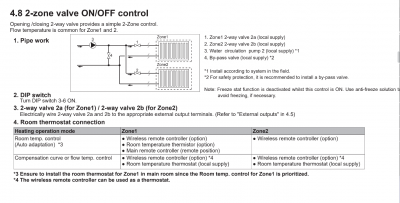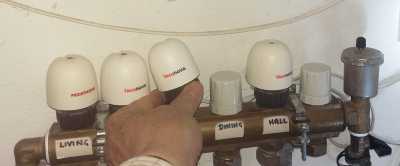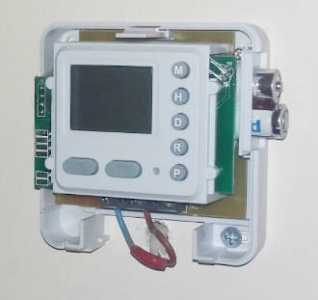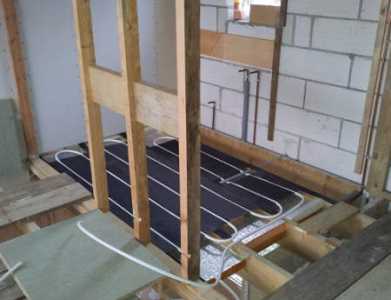Do I need separate UFH pumps?
Does anyone have a view whether the pre-plumbed CH circuit pump on the Ecodan Cylinder could manage the full UFH circuits itself? At present we have pumps on the ufh manifolds on ground and first floor. They are activated from the room thermostats and run 24/7 at the moment regardless of whether the Auto Adaption has the system running or not. (Because the room thermostats are set to call for heat constantly). I am wondering whether I could a) get these pumps removed completely or b) get them rewired so that the Ecodan switches them on rather than the room thermostats.
Posted by: @hjdDoes anyone have a view whether the pre-plumbed CH circuit pump on the Ecodan Cylinder could manage the full UFH circuits itself? At present we have pumps on the ufh manifolds on ground and first floor. They are activated from the room thermostats and run 24/7 at the moment regardless of whether the Auto Adaption has the system running or not. (Because the room thermostats are set to call for heat constantly). I am wondering whether I could a) get these pumps removed completely or b) get them rewired so that the Ecodan switches them on rather than the room thermostats.
Do you have the FTC6 manual? Page 8 shows options for zones and pumps. It looks like you can run 2 zones without external pumps but only if both are at the same temperature.
I thought my pumps only ran when the room stats are calling for heat and the ASHP is below target flow temp. I.e. even though my stats are turned up to 30 deg, the pumps are not running 24x7. I think mine is set up a bit like this.
The pump only runs when the ASHP controller tells it to. All the room stats do is open and close the motorised valves. I do have 2 external pumps but I think they are common to my zones, i.e, one does flow for both zones and the other is return for both zones.
I'm still trying to work out how auto adaptation works in my 2 zones. I think I know now but I'm not sure ...
Sheesh - these instruction manuals are (too) complex. I've just looked at the FTC6 diagrams which @kev-m refers to. It's written to give you lots of possible options rather than explaining why each one might be preferable under particular circumstances.
It's like going to an Indian restaurant with no English translation on the menu, but a photo of each dish instead. Then you're trying to work out how 'hot' is each option 😓
@hjd may I ask some basic questions, the answers to which might better get us to the answer you're really seeking.
And I'll state up front, I'm driving two UFH manifolds from a thermal store rather than directly from a HP, as you are. But mine is a DIY installation which 'evolved' as I gradually understood the principles.
1: Did your manifolds each come in a package that included a pump? Or did the installer do some flow calculations and suggest that you needed a pump for each floor?
2: Does each UFH loop connected to a manifold have its own 'motorised' valve operated by a zone-thermostat for that room?
3: Are these pumps really running full-on 24/7 or do they alter speed (modulate) according to the number of ufh zone-valves which are open? Most modern pumps are modulated, using a sensor to measure the pressure on their output.
4: Why are your room thermostats set to call for heat constantly? Do they also have an inbuilt time-clock to ask for lower temperatures at night, for example?
5: The longer the floor-loop, the slower the water will pass through it. So my smaller loops will initially take more of the flow, but then switch off their zone-valve sooner when that room/zone reaches the set temp. Do you have a rough idea of the lengths of your UFH loops?
6: (referring to a comment from @kev-m) Are you happy that all your UFH circuits are receiving water at the same temperature? Mine do, despite the floor construction differing. Do have a read-out of what temperature the flow-pipe is running at?
7: Before considering whether to get the manifold pumps removed (or controlled by the Ecodan), are they possibly configured such that their operation also mixes return-water with flow-water in order to lower the temperature? This is a common feature of manifolds with combined pumps which are to feed water to wooden floors. The flow might be too hot which risks warping the wood, so some of the return-water is mixed back in.
You don't need to answer each question.
They're there so that you can think through what you want to achieve logically. Only then do we go to the instruction manual to see how it can be achieved.
Nor do we mind if your responses then alter your original question. This is a discussion forum. We're all free to change our mind as we think through a problem!
Save energy... recycle electrons!
Hey - thanks for the detailed reply and your questions, which I have tried to answer below. I've also done a bit more reading up about the Emmetti manifolds and wiring centre and it seems like they are configured by design for the pumps to be triggered by the manifold valve opening - so it probably is working correctly. Ultimately, I guess the impact over the 5 months a year when the heating is on, is relatively limited vs the cost of running the HP!
----------------------------------------------------
Sheesh - these instruction manuals are (too) complex. I've just looked at the FTC6 diagrams which @kev-m refers to. It's written to give you lots of possible options rather than explaining why each one might be preferable under particular circumstances.
It's like going to an Indian restaurant with no English translation on the menu, but a photo of each dish instead. Then you're trying to work out how 'hot' is each option 😓
@hjd may I ask some basic questions, the answers to which might better get us to the answer you're really seeking.
And I'll state up front, I'm driving two UFH manifolds from a thermal store rather than directly from a HP, as you are. But mine is a DIY installation which 'evolved' as I gradually understood the principles.
1: Did your manifolds each come in a package that included a pump? Or did the installer do some flow calculations and suggest that you needed a pump for each floor? They were packaged with the manifold as far as I know
2: Does each UFH loop connected to a manifold have its own 'motorised' valve operated by a zone-thermostat for that room? Yes - as soon as one activates, shortly afterwards it starts the pump and interlock's to the Ecodan cylinder
-- Attachment is not available --
3: Are these pumps really running full-on 24/7 or do they alter speed (modulate) according to the number of ufh zone-valves which are open? Most modern pumps are modulated, using a sensor to measure the pressure on their output. They are Grundfos UPMs - i think they must modulate to some extent as they go from very quiet to noisier dependent on the temp of the flow.
4: Why are your room thermostats set to call for heat constantly? Do they also have an inbuilt time-clock to ask for lower temperatures at night, for example? I turned them up to 23 degrees so that they are not overriding the auto adaption / WC managed by the Ecodan wireless contoller. I could introduce night set back.
-- Attachment is not available --
5: The longer the floor-loop, the slower the water will pass through it. So my smaller loops will initially take more of the flow, but then switch off their zone-valve sooner when that room/zone reaches the set temp. Do you have a rough idea of the lengths of your UFH loops? I don't really although I could probably estimate it based on room size and distance from manifold.
-- Attachment is not available --
6: (referring to a comment from @kev-m) Are you happy that all your UFH circuits are receiving water at the same temperature? Mine do, despite the floor construction differing. Do have a read-out of what temperature the flow-pipe is running at? I think they probably do. A couple of rooms are c. 1 degree colder than others (but I think the manifold flow rate adjusters are set slightly differently).
7: Before considering whether to get the manifold pumps removed (or controlled by the Ecodan), are they possibly configured such that their operation also mixes return-water with flow-water in order to lower the temperature? This is a common feature of manifolds with combined pumps which are to feed water to wooden floors. The flow might be too hot which risks warping the wood, so some of the return-water is mixed back in. I don't think there is any mixing going on as there is not a thermostatic valve on the manifold.
You don't need to answer each question.
They're there so that you can think through what you want to achieve logically. Only then do we go to the instruction manual to see how it can be achieved.
Nor do we mind if your responses then alter your original question. This is a discussion forum. We're all free to change our mind as we think through a problem!
Thanks @hjd - this is becoming a bit clearer now.
Posted by: @hjdDoes each UFH loop connected to a manifold have its own 'motorised' valve operated by a zone-thermostat for that room? Yes - as soon as one activates, shortly afterwards it starts the pump and interlock's to the Ecodan cylinder
I think that's the key point.
It seems that the UFH manifold, associated pump and the room thermostats are all operating as intended. I think they need to be left as at present.
That leaves the outstanding issue to be how the Ecodan and its WC should be configured. Leaving the room 'stats set to 23degC shouldn't be the answer!
It's possible that your system needs a buffer-tank (or store) to allow the heat-pump to continue operating within its design envelope. Alternatively, the 'interlock' back to the Ecodan controller might not be implemented as it should've been.
Those are points which are better picked up by those with experience of WC parameters. Have you read the ongoing discussion involving WC configuration and related matters over on the topic 12kW Samsung short cycling? The best HP experts on this forum are all piling in there!
Save energy... recycle electrons!
Posted by: @hjdDoes anyone have a view whether the pre-plumbed CH circuit pump on the Ecodan Cylinder could manage the full UFH circuits itself? At present we have pumps on the ufh manifolds on ground and first floor. They are activated from the room thermostats and run 24/7 at the moment regardless of whether the Auto Adaption has the system running or not. (Because the room thermostats are set to call for heat constantly). I am wondering whether I could a) get these pumps removed completely or b) get them rewired so that the Ecodan switches them on rather than the room thermostats.
Is your heating system totally UFH or do you have any radiators?
The fact that the additional water pumps came as part of the UFH package, would indicate that they are required for mixing the warm supply and cold return.
If you have radiators in one section of your home, then the Ecodan auto adaptation controller should be located in that area. The thermostats for the UFH should therefore be used to control the temperature in their sections of your home, so should be lowered from the present 23C setting.
Do you have zone valves and if so how many?
- 26 Forums
- 2,364 Topics
- 53.6 K Posts
- 169 Online
- 6,029 Members
Join Us!
Worth Watching
Latest Posts
-

How long will your energy contract last?
Some heat pump tariffs don’t run as long as a heat pu...
By Toodles , 15 hours ago
-

@morgan They are unsupervised these days, can’t get the...
By Toodles , 15 hours ago
-
-
RE: Octopus Cosy Heat Pump Owners & Discussion Thread
@kevh it's worth remembering that many lsvs only actual...
By JamesPa , 2 days ago
-

RE: Setback savings - fact or fiction?
Exactly. We only need to compare conditions, to decide ...
By cathodeRay , 2 days ago
-
RE: Balancing financial efficiency and comfort using the Octopus Cosy tariff
I found because I have very low heat loss I can set bac...
By RadWhisperer , 2 days ago
-
RE: Need Help Optimising My Rushed ECO4 Install: 12kW Bosch Heat Pump
Welcome @mickamills We too have an oversized 12kW Sa...
By Old_Scientist , 2 days ago
-
RE: My Powerwall 3 Consumes 3-4 kWh/Day in Self-Consumption: Is This Normal?
@caron I can confirm that the power usage of the PW3 is...
By Old_Scientist , 2 days ago
-
RE: Speedcomfort radiator fans
Thats true, but having tried (and succeeded) in constru...
By JamesPa , 2 days ago
-
RE: Solis S6-EH1P8K-L-PLUS – Why I Chose It and What I’ve Learned So Far
@bash brilliant, thanks for the feedback
By energy9165 , 2 days ago
-

RE: Heat Pump Heats the House… But It’s Not Cosy. Emitter Changes or System Tweak?
@alastair There I was, feeling grumpy, he said “Cheer u...
By Toodles , 2 days ago
-
RE: Grant Aerona: Is there a setting to keep the 2-port valve open during pump blockade
Depends on OAT. Mine cycles at OAT>10 and of course...
By JamesPa , 3 days ago
-
RE: New Fogstar 15.5kWh upright solution
@transparent My conclusion is as you have noted, tha...
By Bash , 3 days ago
-
RE: Mitsubishi Ecodan R290 10kW performance
And to you too. Wishing you a very enjoyable festive s...
By Sheriff Fatman , 3 days ago
-

RE: External pipework insulation
They do? But that isn't apparent from the photos we'r...
By Transparent , 3 days ago
-

RE: Say hello and introduce yourself
@velcro welcome to the forums. Please feel free start a...
By Mars , 3 days ago
-
Daikin EDLA11D3V3 DHW Settings
I have a newly installed EDLA11D3V3 which I'm still get...
By Velcro , 3 days ago
-
RE: Midea ASHP – how to set weather compensation
@curlykatie did you get sorted with this?
By MickaMills , 4 days ago
-
RE: MyVaillant Connect Regular Disconnect
Thanks. Yes, if the time is consistently 11pm every nig...
By buckwem , 4 days ago








